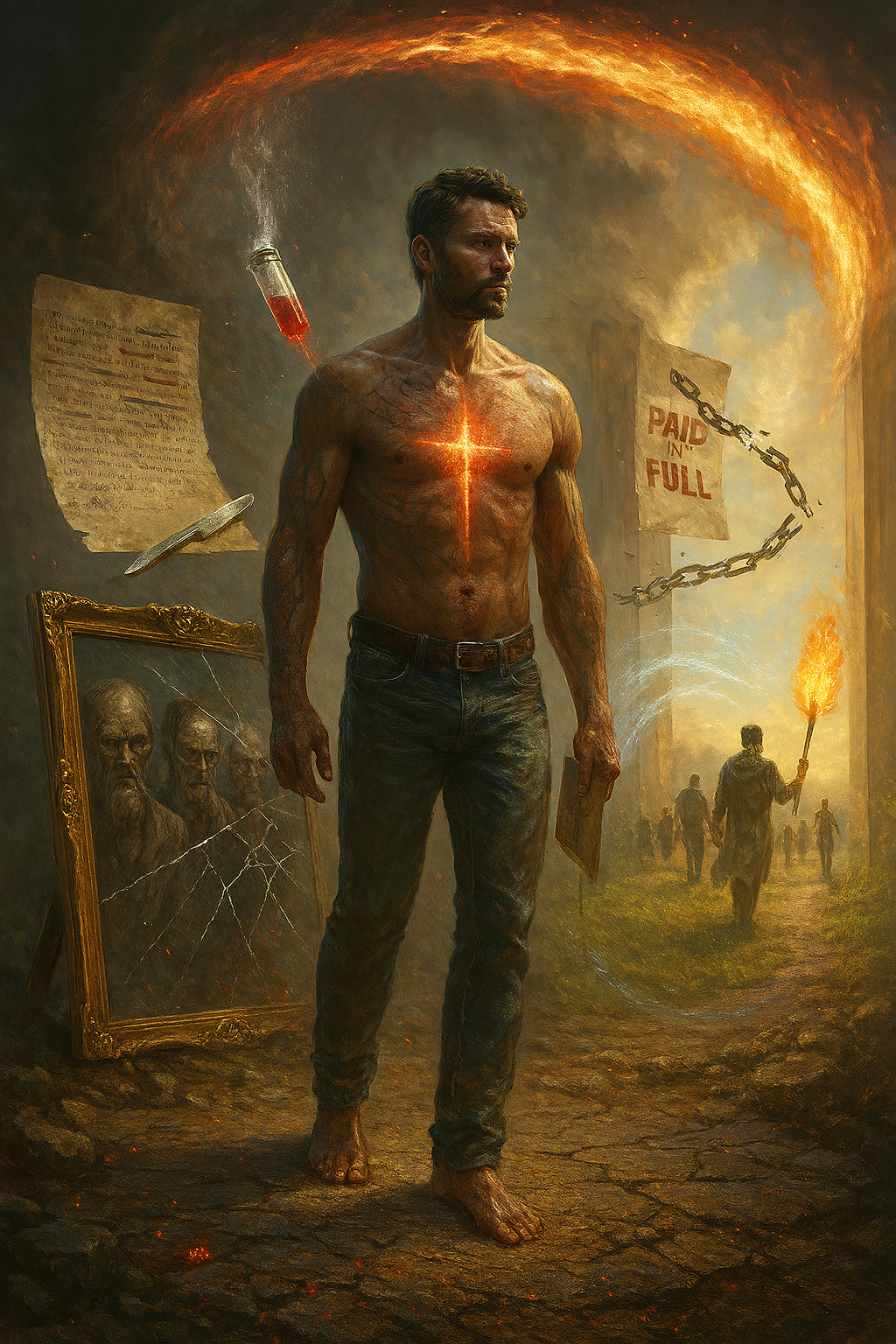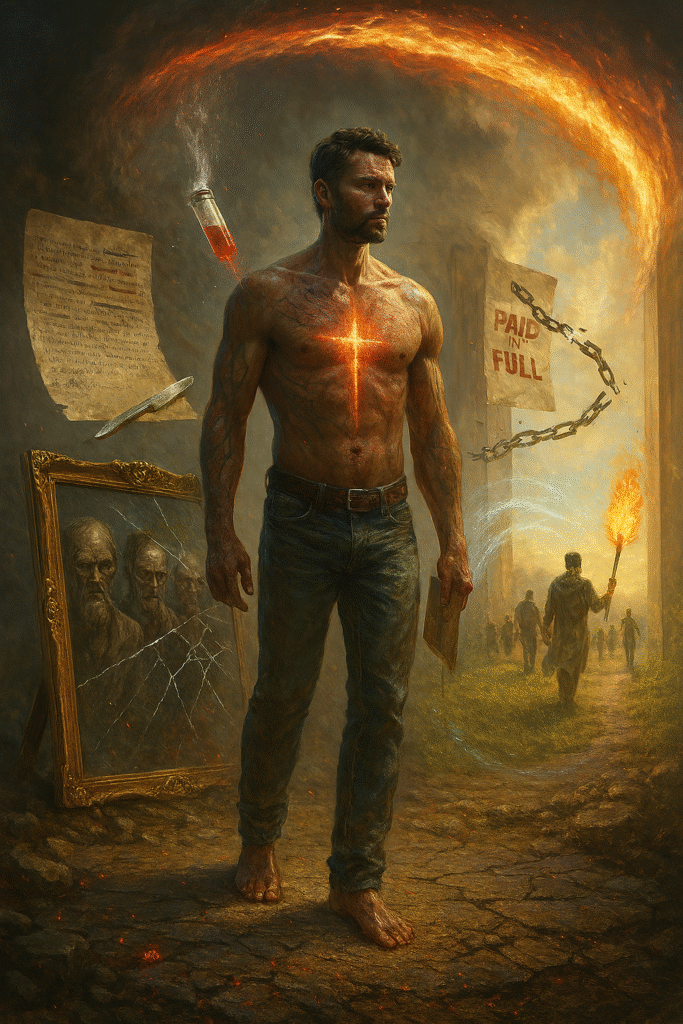Physical Address
304 North Cardinal St.
Dorchester Center, MA 02124
Physical Address
304 North Cardinal St.
Dorchester Center, MA 02124
With Michael Walker
With Michael Walker

A message to the Believer…

There is a difference between being declared righteous and being made righteous. One is a verdict. The other is a transformation. The gospel does not begin with leniency—it begins with justice. And justice, in the biblical framework, is not the absence of punishment but the presence of execution. Every sin is judged. Every penalty is carried out. Nothing is overlooked. Nothing is waived. The cross is not a symbol of divine tolerance—it is the location of divine wrath satisfied. This deep dive explores the verdict rendered in the body of the Son: justice accomplished, condemnation ended, righteousness imparted.
Romans 3:25–26 declares, “Whom God displayed publicly as a propitiation in His blood through faith. This was to demonstrate His righteousness… so that He would be just and the justifier of the one who has faith in Yehoshua.” The cross is not a loophole—it is the convergence of justice and mercy. God did not overlook sin—He extinguished it. He did not excuse the sinner—He executed the penalty in the body of the Substitute. The verdict is not leniency—it is completion.
Isaiah 53:5 confirms, “But He was pierced for our offenses, He was crushed for our wrongdoings; the punishment for our well-being was laid upon Him, and by His wounds we are healed.” This is not poetic lament—it is forensic substitution. The punishment was real. The wounds were literal. The healing was purchased. 1 Peter 2:24 echoes, “He Himself bore our sins in His body on the cross, so that we might die to sin and live for righteousness; by His wounds you were healed.” The body was the location. The cross was the instrument. The verdict was rendered.
Romans 8:1 declares, “Therefore there is now no condemnation at all for those who are in Yehoshua.” This is not emotional comfort—it is legal finality. The condemnation is not pending—it is over. The case is not open—it is closed. The believer is not under review—he is under righteousness. Romans 8:3 explains the mechanism: “For what the Law could not do, weak as it was through the flesh, God did: sending His own Son in the likeness of sinful flesh and as an offering for sin, He condemned sin in the flesh.” The condemnation did not disappear—it was absorbed. The judgment did not evaporate—it was executed.
2 Corinthians 5:21 adds, “He made Him who knew no sin to be sin in our behalf, so that we might become the righteousness of God in Him.” The exchange is total. The sin is transferred. The righteousness is imparted. The verdict is not partial—it is complete. The believer is not merely pardoned—he is transformed.
But guilt is not a metaphysical substance—it is the resonance of infection. When the infection is removed, the resonance collapses. Condemnation ends not because God “feels better,” but because the organism that generated the shame has been extinguished. Hebrews 10:18 declares, “Now where there is forgiveness of these things, an offering for sin is no longer required.” The offering has been made. The blood has been shed. The cure has been administered. To live as if still guilty is to deny the efficacy of the cross. To seek re-justification is to attempt an illegal retrial.
Romans 8:33–34 asks, “Who will bring charges against God’s elect? God is the one who justifies; who is the one who condemns?” The case is closed. The verdict is final. The release is real. The believer is not under accusation—he is under declaration. The righteousness is not theoretical—it is embodied.
But sin, though judged in the body of the Son, still seeks a host. And if not contained, it will spread. It needs a cure. And it needs to be contained in fire—as if it cannot be destroyed. This is why the imagery of fire is so prevalent. Not as torture, but as containment. Matthew 13:41–42 says, “The Son of Man will send forth His angels, and they will gather out of His kingdom all stumbling blocks, and those who commit lawlessness, and they will throw them into the furnace of fire; in that place there will be weeping and gnashing of teeth.” The fire is not described as a place of arbitrary torment—it is a furnace, a containment zone for what cannot be allowed to spread. It is the divine firewall against spiritual contagion. Sin is not destroyed—it is quarantined.
Even after the thousand-year reign of Yehoshua, Revelation 20:7–8 declares, “When the thousand years are completed, Satan will be released from his prison, and will come out to deceive the nations.” This is staggering. After a millennium of peace, after the visible reign of the Messiah, deception still finds a host. This suggests that sin, though restrained, is not eradicated. It remains latent, waiting for a vessel. And God, in His justice, allows the test—not to torment, but to reveal allegiance. The choice must be made freely, even after seeing the Messiah face to face.
This is not cruelty—it is coherence. God does not bypass the will. He does not override the heart. Even in the presence of glory, the human soul must choose. And sin, ever lurking, ever seeking a host, will find those who have not been cured. And they, by their own volition, will embrace the infection. And the infection, once embraced, must be contained. This is why sin is never described as being destroyed. It is described as being judged, cast out, burned, restrained. It is a force that cannot be allowed to roam, but it is also a force that cannot be destroyed without destroying the vessel. And God, in His mercy, does not delight in the destruction of His creation. Ezekiel 33:11 declares, “I take no pleasure in the death of the wicked, but rather that the wicked turn from his way and live.” The fire is not for pleasure—it is for protection.
To understand this, consider the closed case file. No prosecutor can reopen a case that’s been ruled and sealed. Or the burned-out virus. Once the virus is eradicated, the symptoms no longer define the patient. Or the two clocks. Heaven’s clock says “clean.” Earth’s clock is catching up. Confession aligns the conscience to the higher verdict. Or the courtroom echo. The gavel has fallen, but the echo still rings in the ears of those who haven’t yet heard the verdict. Or the illegal retrial. To condemn a believer after the cross is to attempt a prosecution that heaven has already dismissed.
This is the pastoral call. Teach the verdict. Declare the righteousness. End the condemnation. Refuse the retrial. Live from the higher court. Align the conscience to the closed case. Train the healed to walk in holiness. Guard the cure. Contain the infection. The verdict has been rendered. The justice has been satisfied. The condemnation has ended. The righteousness has been imparted. The fire stands ready. Live as one who has been declared clean—and walk as one who carries the cure.